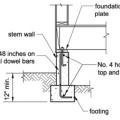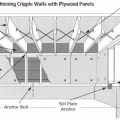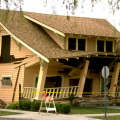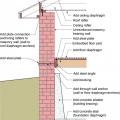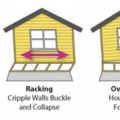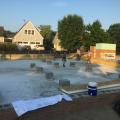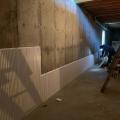Scope
When constructing or retrofitting homes with basement foundations, crawlspace foundations, or crawlspace foundations with a "cripple" wall, connect the house walls to the foundation and connect the structural elements to each other to withstand seismic activity.
- Connect the wall to the floor diaphragm.
- Connect the floor diaphragm to the foundation with anchor bolts.
- Install building bracing.
- Install control layers to improve the energy efficiency and durability of the structure, including a rain control layer, an air control layer, a vapor control layer, and a thermal control layer.
See the Compliance Tab for links to related codes and standards and voluntary federal energy-efficiency program requirements.
Description
This guide describes options for providing seismic and thermal resistance for homes with basement foundations, crawlspace foundations, or crawlspace foundations with a “cripple” wall.
Seismic Design Approach
Most of the damage to a building during an earthquake is caused by lateral movements that disconnect the house from its foundation. Uplift forces can also occur. These lateral loads (shear) and uplift forces due to ground movement need to be transferred to the ground to minimize the likelihood of the building being pulled apart. New homes and existing homes need to be connected to their foundations and the structural elements should be connected to each other to withstand seismic activity.
Although unrelated to earthquake resistance, when retrofitting a foundation to make it more earthquake resistant, the foundation should also be assessed to see if the insulation, air sealing, and moisture protection could be improved to make the home more thermally efficient and durable.
Building-to-Foundation Connection
Figure 1 illustrates the three foundation types covered in this guide: a basement foundation, crawlspace foundation, and crawlspace foundation with a cripple wall. Note in all three foundations the connection of the continuous exterior structural wood sheathing (plywood or oriented strand board “OSB”) to the foundation sill plate. Also, note that the foundation sill plate is connected to the concrete foundation with a foundation anchor bolt. In this manner, the wall and -floor diaphragms are connected to each other and to the foundation.
Building bracing is provided by the use of continuous exterior structural wood sheathing (plywood or OSB). Note that the crawlspace foundation with a cripple wall has structural wood sheathing on both sides. Main-floor walls are internally reinforced with gypsum sheathing.
Additional bracing is provided in both crawlspace assemblies by installing cross bracing at interior posts and piers (Figure 2).
All three foundation types should also have solid blocking of dimensional lumber installed between the floor joists. (The blocking is shown in Figure 2 as the white boxes with black outlines between the floor joists.) The solid wood blocking prevents the floor joists from racking or rolling sideways.

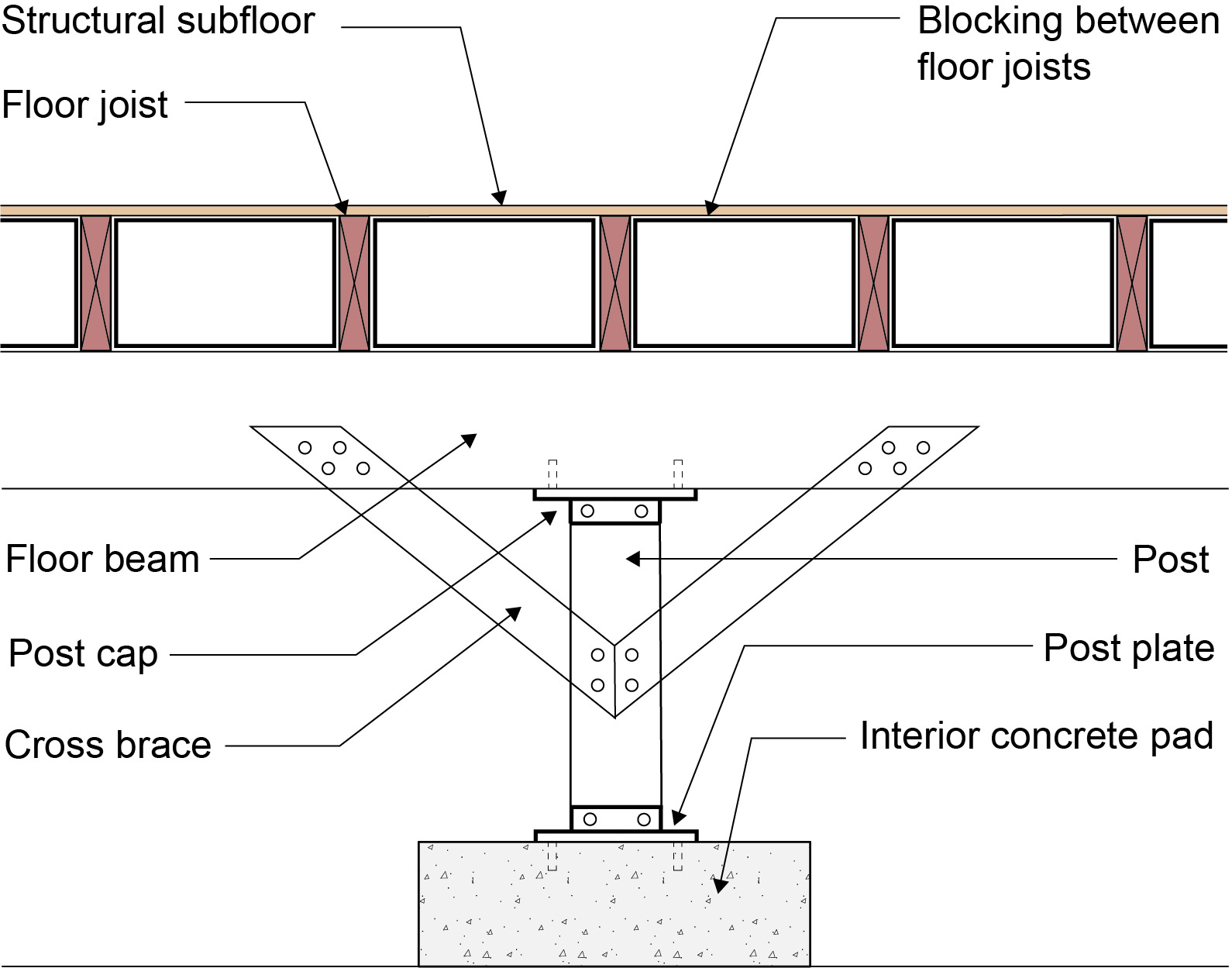
Thermal Efficiency
New homes and existing homes should be thermally efficient. The basis of all thermal efficiency is to provide environmental separation. Environmental separation requires a continuous water control layer (rain and groundwater), a continuous air control layer (air barrier), a vapor control layer, and a thermal control layer (insulation).
Basement Foundation
Figure 3 illustrates one option for installing environmental separation in a basement foundation. In some cases, one product can serve as multiple control layers.
A continuous water control layer for controlling rainwater is installed on the exterior of the above-grade walls’ structural sheathing; this is connected to the continuous water control layer on the exterior of the basement foundation. This below-grade water control layer, not shown in the figure, could be a fluid-applied waterproofing membrane or dimpled plastic drain mat. A continuous air control layer is installed on the exterior of the above-grade walls’ structural sheathing and is connected to the concrete foundation wall, which is acting as the foundation air control layer. In Figure 3, one product serves as both the water and air control layer. This product could be a fully adhered membrane, a fluid-applied membrane, or house wrap with seams overlapped and taped. The sealed rigid insulation serves as the air control layer on the basement foundation.
Vapor control is provided by controlling the temperature of the wall assembly condensing surface by installing continuous exterior insulation. Vapor control of the concrete foundation is provided by installing damp proofing on the exterior of the foundation wall and a sheet of polyethylene under the foundation slab.
Thermal control is provided by installing continuous rigid insulation exterior of the framing and cavity insulation within the wall cavities. Rigid insulation is installed on the interior of the basement foundation wall.
This approach works in all climates.
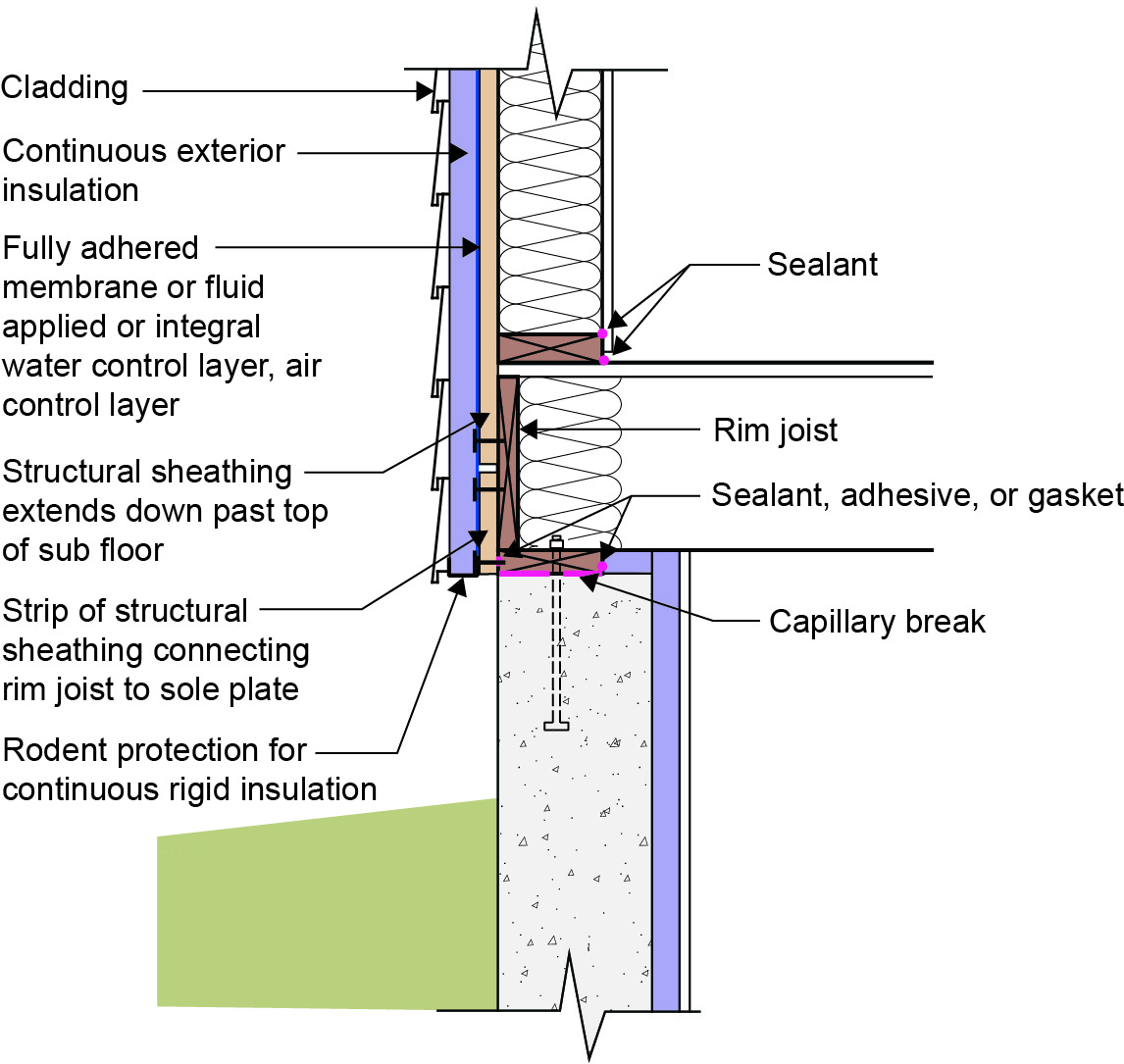
Crawlspace Foundation
Figure 4 illustrates one option for insulating vented crawlspaces.
A continuous water control layer for controlling rainwater is installed on the exterior of the wall structural sheathing and is connected to the continuous water control layer on the exterior of the concrete foundation stem wall. This water control layer for the above-grade walls could be the rigid foam shown in Figure 4 if the seams are taped and the edges are sealed; it could also be a fully adhered membrane, a fluid-applied membrane, or house wrap with seams overlapped and taped. These products could also serve as the above-grade air barrier. A fluid-applied waterproofing membrane or dimpled plastic drain mat could serve as the water control layer for the below-grade walls.
The above-grade air control layer is installed on the exterior of the wall structural sheathing and is connected to the top of the concrete foundation stem and in turn to the continuous rigid insulation installed under the floor joists. The continuous rigid insulation under the floor joists is sealed at all seams to act as the air control layer of the insulated floor assembly.
Vapor control is provided by controlling the temperature of the wall assembly condensing surface by installing continuous exterior insulation. Vapor control of the crawlspace foundation is provided by installing impermeable continuous rigid insulation under the floor joists. Additionally, a continuous polyethylene ground cover is provided.
Thermal control is provided by installing continuous rigid insulation exterior of the sheathing and cavity insulation within the wall cavities. Additionally, continuous rigid insulation is installed under the floor joists.
This approach works in all climates.
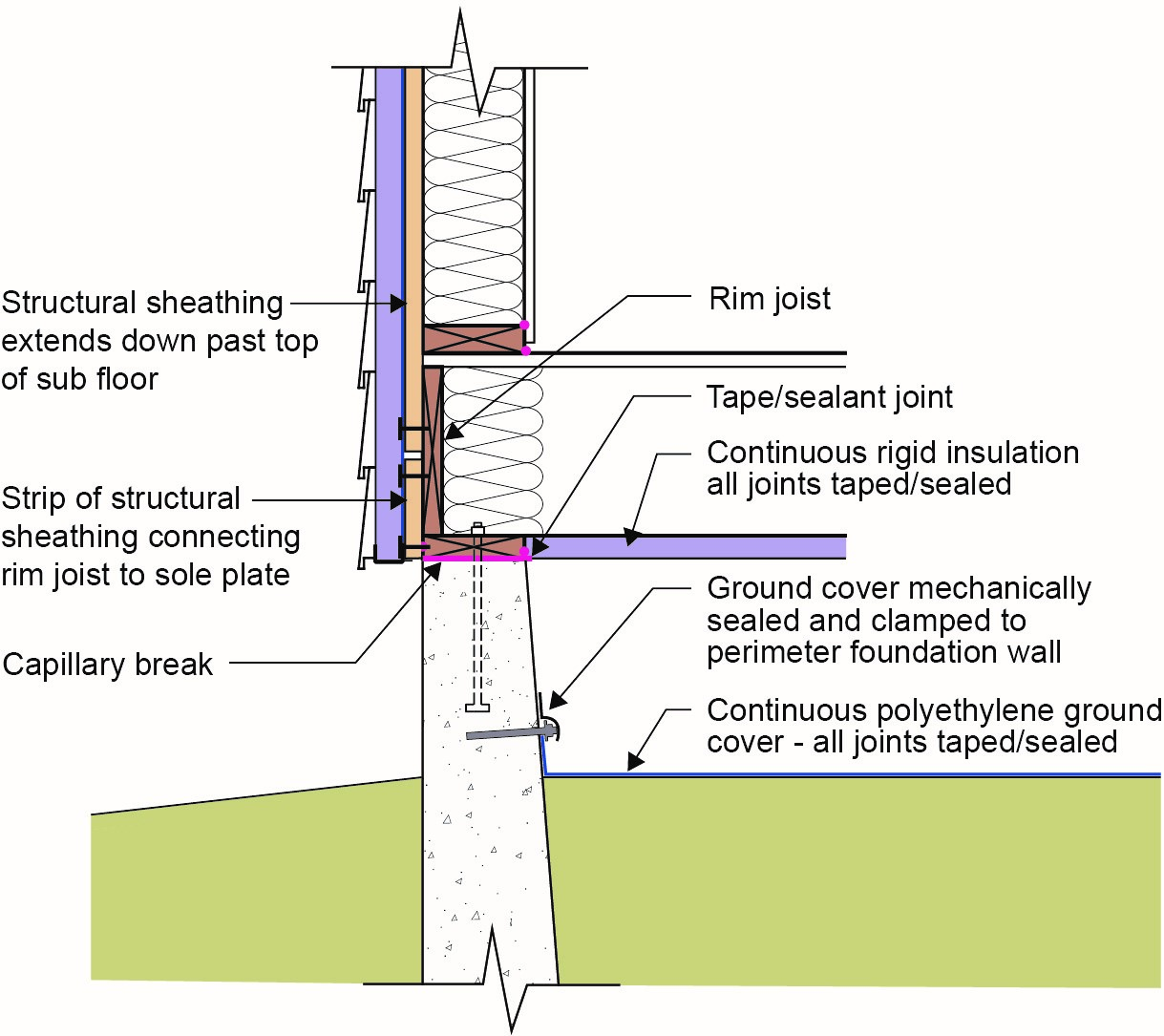
Crawlspace Foundation with a Cripple Wall
Figure 5 illustrates one option for insulating an unvented crawlspace foundation with cripple walls. A cripple wall is a short wall that rests on the foundation and supports the floor and exterior walls (Figure 5).

A continuous water control layer for controlling rainwater is installed on the exterior of the wall structural sheathing and is connected to the continuous water control layer on the exterior of the concrete foundation stem wall. This water control layer for the above-grade walls could be the rigid foam shown in Figure 6 if the seams are taped and the edges are sealed; it could also be a fully adhered membrane, a fluid-applied membrane, or house wrap with seams overlapped and taped. These products could also serve as the above-grade air barrier. A fluid-applied waterproofing membrane or dimpled plastic drain mat could serve as the water control layer for the below-grade walls.
The above-grade air control layer is installed on the exterior of the wall structural sheathing and is connected to the top of the concrete foundation stem wall and in turn to a continuous polyethylene ground cover that is extended up the interior of the concrete foundation stem wall.
Vapor control is provided by controlling the temperature of the wall assembly condensing surface by installing continuous exterior insulation. Vapor control of the crawl space foundation is provided by installing a continuous polyethylene ground cover that is extended up the interior of the concrete foundation stem wall. Figure 7 illustrates continuity of the air and vapor control layers at the interior posts and piers.
Thermal control is provided by installing continuous rigid insulation exterior of the sheathing and cavity insulation in the wall cavities. Additionally, foil-faced or plastic-faced batt insulation is installed on the interior of the concrete foundation stem wall and extends horizontally over the polyethylene ground cover at the perimeter of the crawl space.
This approach works in all climates with the following limitation – in Climate Zones 5 and higher, the foil-faced or plastic-faced batt or roll insulation must be replaced with impermeable rigid insulation or closed cell spray polyurethane foam.
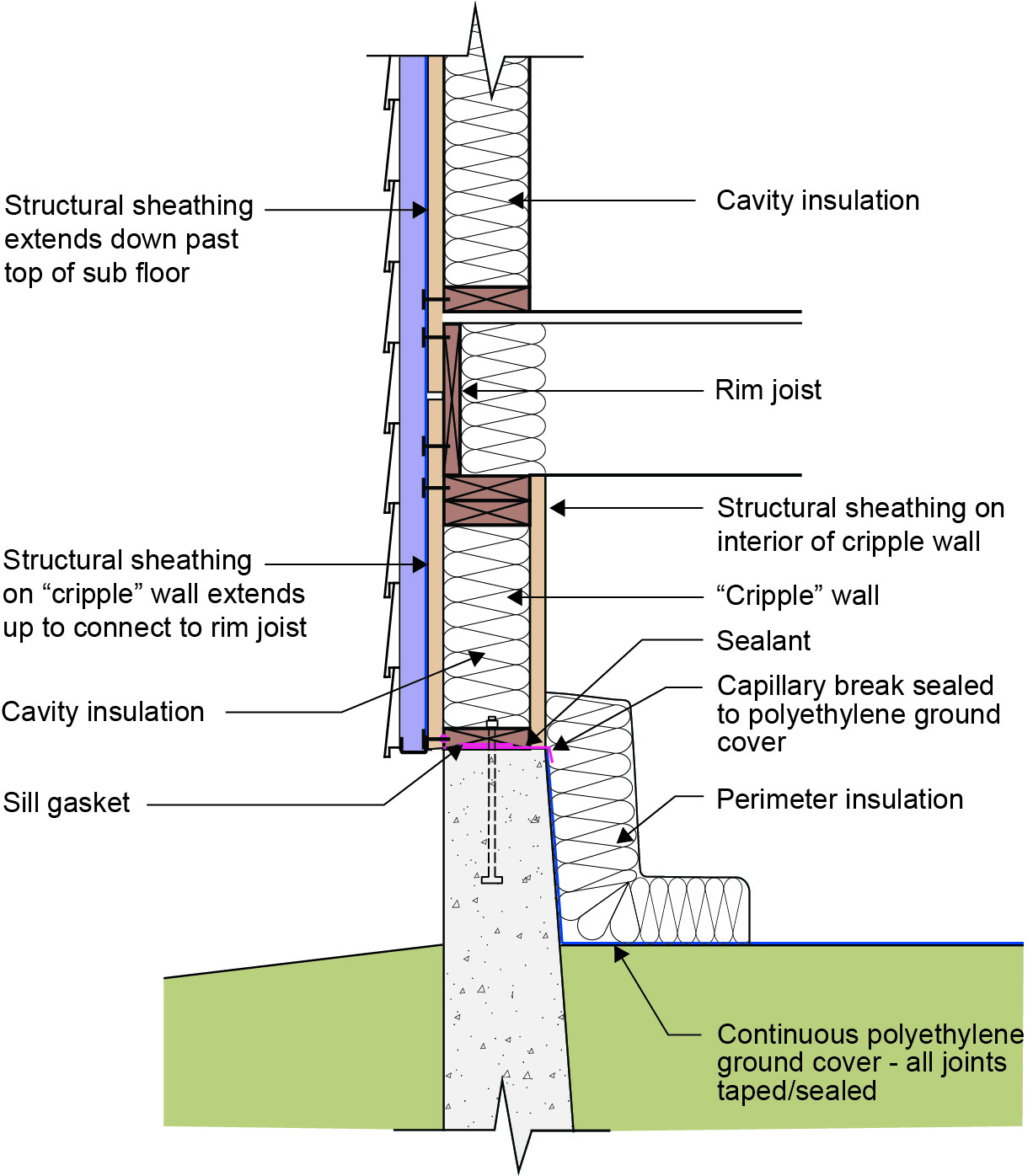
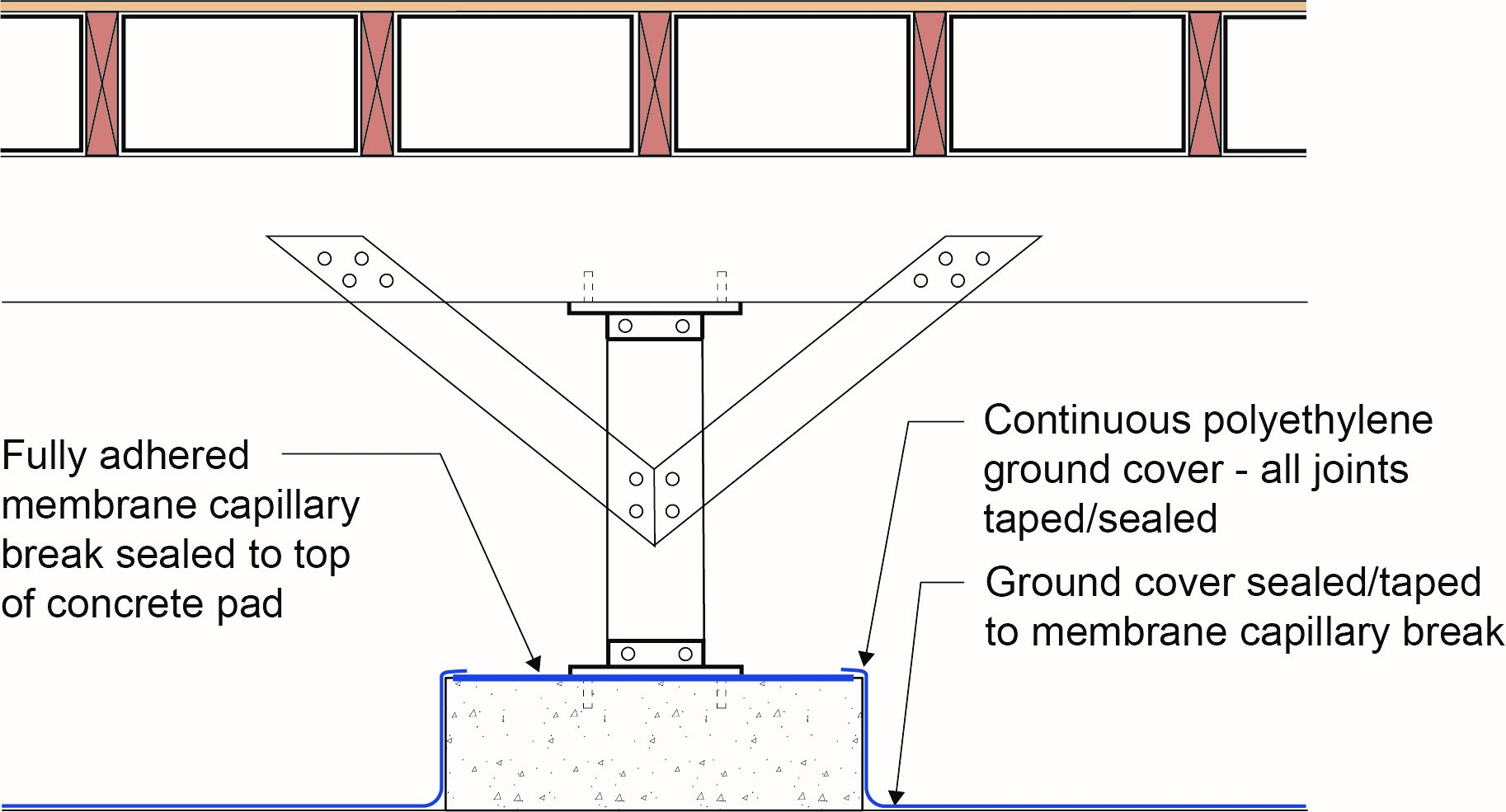
Success
Consult a licensed architect or engineer to develop a detailed design and approach for the home to withstand seismic activity. Thermal efficiency should be incorporated as required by code.
Climate
Earthquake Areas
The approaches to seismic control will work in all climates. However, check local building codes for specific requirements as seismic risk and requirements vary based on location; see map below. Insulation requirements for thermal efficiency are climate dependent; see the Compliance tab and consult local code for requirements.
The International Residential Code (IRC) takes a building’s seismic risk into account based on location. The IRC contours the United States into seismic design categories, from low risk to high risk as shown in Figure 1, which designates the categories by letter: A, B, C, D0, D1, D2, and E, with A designating the lowest risk and E designating areas with the highest risk. The IRC has design guidelines for categories A through D2 as well as scenarios for when a building in design category E can be reassigned to category D2. If a building located in design category E cannot be reassigned to category D2, then it must be designed using the International Building Code (IBC), not the IRC.

Training
Compliance
Retrofit
The approach to seismic retrofit is the same as the approach to new design for seismic resistance. The basis of all earthquake resistance is to control and transfer lateral loads (“sheer”) caused by ground movement to foundations and the ground. The Earthquake Overview guide in the Building America Solution Center provides extensive guidance on retrofitting measures to strengthen cripple walls.
More
More Info.
Access to some references may require purchase from the publisher. While we continually update our database, links may have changed since posting. Please contact our webmaster if you find broken links.
The following authors and organizations contributed to the content in this Guide.
Building Science Corporation
Pacific Northwest National Laboratory

